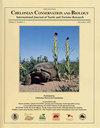坎普的《雷德利海龟》中鱼钩摄入的普遍性和短暂性
IF 0.8
4区 生物学
Q3 ZOOLOGY
引用次数: 7
摘要
在墨西哥湾北部,肯普雷德利海龟(Lepidochelys kempii)偶然被休闲垂钓者捕获。虽然海龟兼捕是一个值得关注的保护问题,但大多数研究都集中在商业渔业上,而受休闲渔业相互作用影响的海龟的数量和比例尚不清楚。这项研究旨在量化密西西比湾海龟的比例,并提供以前与垂钓者互动的证据。我们分析了在康复过程中捕获的用钩和线捕获的海龟的x线照片,以了解存在的钩的数量、钩的位置和相关钩相互作用的数量。在一些康复的肯皮鲤中,摄入的钩的存在也使我们能够通过观察康复来报告钩的短暂性,包括转运时间如何与海龟的大小、钩的大小和胃肠道内的位置相关。从2012年到2015年,对882只L. kempii进行了x线摄影。在我们的总样本中,12.5%的样本中发现了先前相互作用的钩子。在我们的样本中,尽管外壳长度确实占钩尺寸变化的21.9%,但外壳长度与齿轮存在的概率没有显著相关。记录了50个成功驱逐的钩子的过境时间。上、中、下消化道的平均通过时间分别为13.50、8.40和4.48 d。多元线性回归模型表明,鱼钩和海龟的大小与转运时间无关。这些信息可用于为海龟的康复、保护和管理决策提供信息,同时强调需要更好地了解海龟与休闲渔业之间的相互作用。本文章由计算机程序翻译,如有差异,请以英文原文为准。
Prevalence and Transience of Ingested Fishing Hooks in Kemp's Ridley Sea Turtles
Abstract In the northern Gulf of Mexico, Kemp's ridley sea turtles (Lepidochelys kempii) are incidentally captured by recreational anglers. While sea turtle bycatch is of conservation concern, most studies focus on commercial fisheries, and the number and proportion of turtles affected by recreational fisheries interactions is not known. This study aimed to quantify the proportion of turtles in the Mississippi Sound with evidence of previous interactions with anglers. We analyzed radiographs of hook-and-line captured sea turtles in rehabilitation for number of hooks present, location of hooks, and number of associated hook interactions. The presence of ingested hooks in a number of the rehabilitated L. kempii also allowed us to report on hook transience through observations in rehabilitation, including how transit time related to turtle size, hook size, and position within the gastrointestinal tract. From 2012 to 2015, 882 L. kempii were radiographed. Hooks from prior interactions were found in 12.5% of our total sample. Carapace length was not significantly related to the probability of gear presence, though carapace length did account for 21.9% of the variation of hook sizes in our sample. Transit times were recorded for 50 successfully expelled hooks. Average transit times were 13.50, 8.40, and 4.48 d for the upper, middle, and lower gastrointestinal tract, respectively. Multiple linear regression models showed that transit time was not related to hook or turtle size. This information can be used to inform sea turtle rehabilitation, conservation, and management decisions while highlighting the need for a better understanding of interactions between sea turtles and recreational fisheries.
求助全文
通过发布文献求助,成功后即可免费获取论文全文。
去求助
来源期刊
CiteScore
1.70
自引率
14.30%
发文量
17
审稿时长
>12 weeks
期刊介绍:
Chelonian Conservation and Biology is a biannual peer-reviewed journal of cosmopolitan and broad-based coverage of all aspects of conservation and biology of all chelonians, including freshwater turtles, marine turtles, and tortoises. Manuscripts may cover any aspects of turtle and tortoise research, with a preference for conservation or biology. Manuscripts dealing with conservation biology, systematic relationships, chelonian diversity, geographic distribution, natural history, ecology, reproduction, morphology and natural variation, population status, husbandry, community conservation initiatives, and human exploitation or conservation management issues are of special interest.

 求助内容:
求助内容: 应助结果提醒方式:
应助结果提醒方式:


